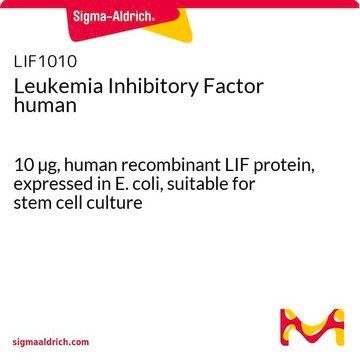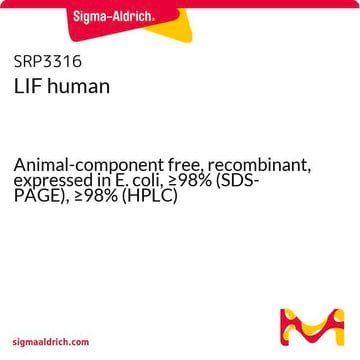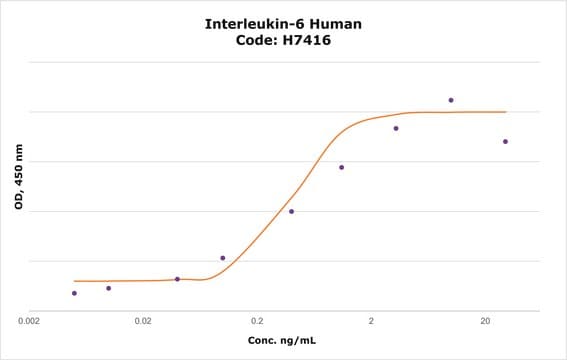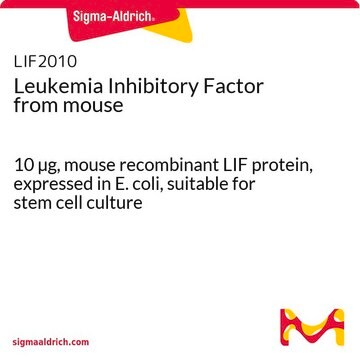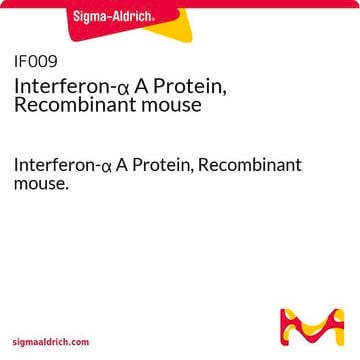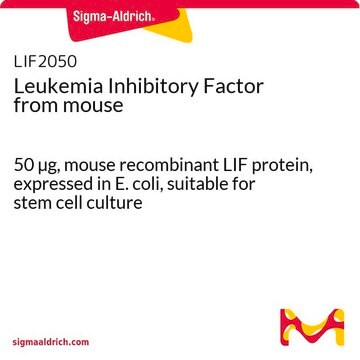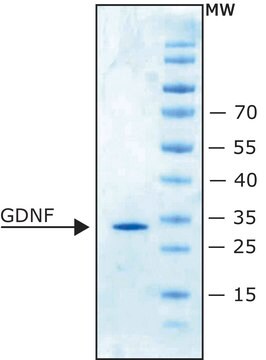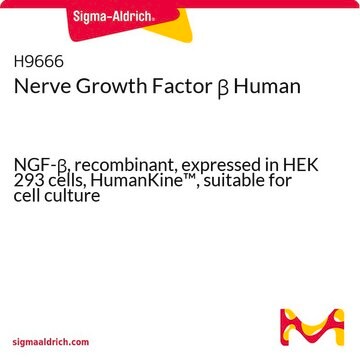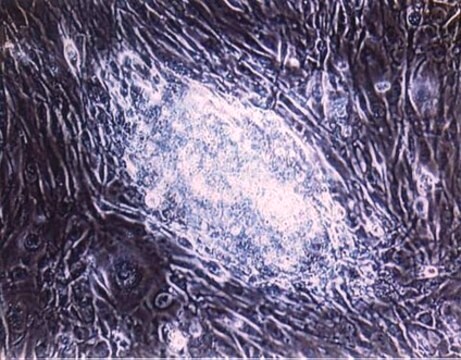추천 제품
제품명
Leukemia Inhibitory Factor human, LIF, recombinant, expressed in E. coli, 10 μg/ml, buffered aqueous solution (pH 7.4), suitable for cell culture
재조합
expressed in E. coli
Quality Level
분석
≥95% (SDS-PAGE)
양식
buffered aqueous solution (pH 7.4)
효능
0.1-1.5 ng/mL ED50/EC50
품질
endotoxin tested
기술
cell culture | mammalian: suitable
저장 온도
2-8°C
유사한 제품을 찾으십니까? 방문 제품 비교 안내
관련 카테고리
생화학적/생리학적 작용
Leukemia Inhibitory Factor (LIF) is a pleiotropic glycoprotein originally described to inhibit the proliferation of the murine myeloid leukemic cell line M1, while inducing differentiation into macrophages. Other activities were later identified to LIF, which is known by a variety of synonyms, including DIF, D-factor, DIA, DRF, CNDF, HILDA, HSF-III, and MLPLI. Human LIF exerts its actions through a receptor comprising a 190 kDa LIF-binding α-chain (130 kDa, mouse) and a 130 kDa signal-transducing β-chain (gp130), which is shared with CNTF, OSM, L-6 and IL-11. As such, it is a member of the gp130 family of the cytokine receptor superfamily. LIF receptors have been identified on several cells, including monocytes, liver, placenta and embryonic stem cells. Natural LIF is heavily glycosylated, showing an apparent molecular weight of 32 kDa to 62 kDa, depending on the source, but absence of glycosylation appears not to affect its biological activity. A single gene encodes LIF, which is secreted as a single chain glycoprotein containing 180 amino acids for human or mouse with a conserved disulfide bond. Human and mouse LIF share 78% sequence homology. Human LIF can activate mouse cells, but mouse LIF cannot activate human cells.
Leukemia Inhibitory Factor (LIF) is a pleiotropic glycoprotein that inhibits the proliferation of the murine myeloid leukemic cell line M1, while inducing differentiation into macrophages. Human and mouse LIF share 78% sequence homology. Human LIF can activate mouse cells, but mouse LIF cannot activate human cells.
물리적 형태
Solution, 0.2 μm filtered, in phosphate buffered saline containing 0.02% TWEEN® 20.
분석 메모
The proliferative activity of human LIF is measured in culture using the human leukemic cell line, TF-1.
법적 정보
TWEEN is a registered trademark of Croda International PLC
Storage Class Code
11 - Combustible Solids
WGK
WGK 3
Flash Point (°F)
Not applicable
Flash Point (°C)
Not applicable
개인 보호 장비
Eyeshields, Gloves, type N95 (US)
이미 열람한 고객
Magda Tomala et al.
Protein expression and purification, 73(1), 51-57 (2010-04-13)
Leukemia inhibitory factor (LIF) is a polyfunctional cytokine with numerous regulatory effects in vivo and in vitro. In stem cell cultures it is the essential media supplement for the maintenance of pluripotency of embryonic and induced pluripotent stem cells. With
N M Gough et al.
Proceedings of the National Academy of Sciences of the United States of America, 85(8), 2623-2627 (1988-04-01)
A human homologue of the recently cloned murine leukemia-inhibitory factor (LIF) gene was isolated from a genomic library by using the murine cDNA as a hybridization probe. The nucleotide sequence of the human gene indicated that human LIF has 78%
Dumrongkiet Arthan et al.
Cancer letters, 297(1), 31-41 (2010-06-24)
Medullary thyroid carcinoma (MTC) is a multiple endocrine neoplasia type 2 syndrome caused by mutations in extracellular receptor or intracellular kinase domains of the RET proto-oncogene. Activation of the Ras/Raf/MEK/ERK pathway can lead to growth arrest by secreting leukemia inhibitory
Borhane Annabi et al.
Journal of neuroinflammation, 6, 8-8 (2009-03-11)
The CD133(+) stem cell population in recurrent gliomas is associated with clinical features such as therapy resistance, blood-brain barrier disruption and, hence, tumor infiltration. Screening of a large panel of glioma samples increasing histological grade demonstrated frequencies of CD133(+) cells
Young Mok Lee et al.
Biology of reproduction, 75(3), 380-386 (2006-05-26)
In this study, we proposed a testis-mediated germline chimera production system based on the transplantation of testicular cells directly into heterologous testes. The testicular cells of juvenile (4-wk-old) or adult (24-wk-old) Korean Ogol chickens with a recessive pigmentation inhibitory gene
문서
Naive pluripotent stem cells are located within the epiblast of mature blastocysts. These primitive “ground-state” cells may be cultured in vitro using specialized media and small molecule inhibitors.
자사의 과학자팀은 생명 과학, 재료 과학, 화학 합성, 크로마토그래피, 분석 및 기타 많은 영역을 포함한 모든 과학 분야에 경험이 있습니다..
고객지원팀으로 연락바랍니다.
